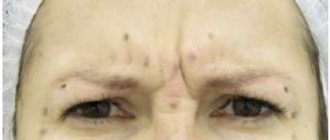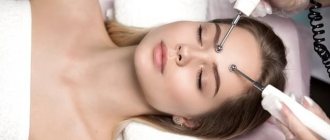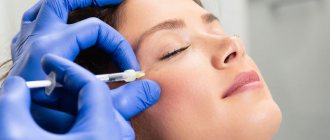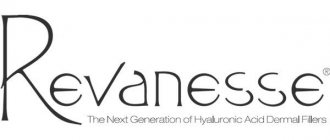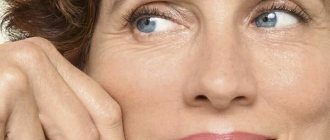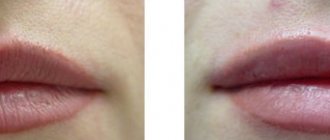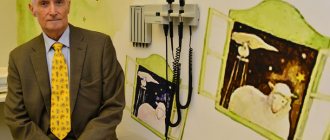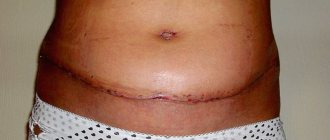Botulinum toxin preparations in aesthetic medicine. Part 2.
Botulinum toxin type A preparations Botox® and Dysport® were first approved in the United States in 2002 and 2009, respectively, for cosmetic purposes, namely the temporary reduction of the visible appearance of medium and deep glabellar lines, formed due to contraction of the procerus and corrugator muscles, in individuals under 65 years of age. Subsequently, BTA preparations began to be used to eliminate bands on the neck, facial wrinkles on the bridge of the nose, forehead, in the corners of the eyes, around the mouth and in the chin area, as well as for non-cosmetic indications: to relax the facial muscles for the treatment of spasms of the half of the face or facial dyskinesia , for the treatment of chronic pain.
Botulinum toxin type A preparations Botox® and Dysport®
The dosage of BTA preparations should be determined based on muscle mass (contracted and relaxed) and the desired intensity and duration of effect. In addition, you should take into account the proportions of the face, the direct dependence of the severity of wrinkles on age, and the difference between the muscle sizes of men and women. The main method for choosing the point of drug administration is observation of muscle contraction.
Commentary by a cosmetologist, dermatovenerologist, doctor of medical sciences, professor, head. Department of Dermatovenerology and Cosmetology of the State Budgetary Educational Institution of Higher Professional Education "GGMU of the Ministry of Health of Russia" Yutskovskaya Y.A.:
— Gender characteristics within the framework of complex botulinum therapy are fundamentally important for understanding a specialist in the field of cosmetology. The method of correcting dynamic expression wrinkles with botulinum toxin is highly effective in both women and men. However, when seeking solutions to their problems, men and women pursue different goals, which is explained by their gender. Therefore, in order for BTA drugs to become the “drugs of choice” in the treatment of hyperkinetic wrinkles in men, it is necessary to use the correct doses of the drug and be sure to take into account the gender characteristics of the patient, since first of all they visualize aging.
Between the eyebrows: vertical wrinkles
The area between the eyebrows is represented by muscles that, from the point of view of functional load, perform a depressor function: the m.procerus, when contracted, pulls the skin of the medial part of the eyebrow and the central part of the forehead down to the bridge of the nose, forming a horizontal wrinkle in the area of the glabella. Due to the contraction of the muscle that corrugates the eyebrow (m.corrugator supercilli), the eyebrows are reduced to the midline and downward and vertical glabellar wrinkles are formed. The action of BTA in this case is aimed at reducing the facial activity of both muscles. The goal of BTA therapy is to reduce the severity of vertical and horizontal wrinkles between the eyebrows. The injection points of the drug are determined based on observation of muscle contraction, palpation and in accordance with anatomical landmarks.
The generally accepted dose of BTA preparations for the eyebrow area is 20 units. Botox® or 50 units. Dysport®. This volume is usually injected at five points. Note that the indicated dosages of BTA are designed for women; men require a larger volume of the drug to achieve a similar effect. Injections are performed intramuscularly in a direction perpendicular to the skin surface. In most cases, the first injection is made into the pride muscle at the point of intersection of imaginary lines drawn from the beginning of the eyebrow to the corner of the opposite eye. Two points of injection of the BTA drug, located 0.5-1 cm above the inner corners of the eyes, are the most significant for the final cosmetic effect of the procedure for eliminating glabella wrinkles. After administering the injection to these points, without removing the needle, move it under the skin at an angle of approximately 1 cm higher and inject the remaining volume of the BTA drug (Figure 1)
.
Figure 1. BTA reference points in the glabella
Using the index finger of the free hand, placed below the eyebrow, you can control the depth of needle insertion and thereby avoid its penetration through the ocular septum and weakening the levator palpebral muscle. This technique, using both hands, also allows one to estimate the amount of muscle tissue requiring BTA injection.
Comment by cosmetologist, dermatovenereologist Ya. A. Yutskovskaya:
— According to modern ideas about the treatment of facial wrinkles with Dysport based on the consensus of the International Expert Council, individually adapted doses vary in the range of 30-70 units. depending on the structure and volume of muscles, the severity of hypertonicity and the patient’s wishes regarding the degree of limitation of facial expressions. When correcting wrinkles formed during active contraction of m. Corrugator supercilii, the drug is injected into only one or two pairs of points. When working with the m.corrugator, we inject the first point deeply, up to the periosteum, because this is the deep-lying pyramidal part of the m.corrugator (Figure 3). In a man, the muscle fiber is dense and voluminous, so the injection is sometimes deep into the entire needle. On average, we introduce 15-20 units, and sometimes 25 units. Dysport drug at one point. The second point is used to correct the “tail” m. сorrugatorsupercilii, pricks superficially, along the line of the eyebrow, never higher, because the fibers of the m.frontalis are attached there. During injection, the tip of the needle is directed from the edge of the orbit, the beveled hole of the needle is directed towards the interglabellar area (in the direction opposite to the muscle that lifts the upper eyelid). From our experience, we recommend injecting approximately ½ of the dose used when treating the main (first) points into the second pair of points. The average dose is 5 units. drug Dysport.
According to anatomists, m.procerus is most often found biceps, when the muscle consists of two bundles intertwined with the fibers of m.corrugator supercilii. We prefer to inject at two points in the area between the eyebrows. This allows you to correct the contraction of both bellies of the muscle, even with a fairly large length and strength of its fibers. The total dose of the drug administered to the m.procerus in men is 10-15 units of Dysport, depending on the pattern of hypertonicity.
Complications: Injection within 1 cm of the bony border of the orbit or near the supraorbital notch may result in eyelid ptosis due to relaxation of the levator palpebrae superioris muscle.
Some authors also suggest administering a minimal volume of highly concentrated BTA preparation to reduce its spread to nearby muscles. Ptosis may appear within 48 hours or 7-10 days after the procedure. Ptosis also tends to intensify during the day due to muscle fatigue. The best way to avoid blepharoptosis is the correct technique for administering BTA. The manifestations of ptosis can be reduced with the help of alpha-adrenergic agonists for external use. Stimulation of the Müller muscle is possible with apraclonidine or phenylephrine eye drops. It is worth remembering that eyelid ptosis is temporary and goes away after a few weeks.
How many units can you inject?
The norm of the administered substance is determined by a specialist. In this case, it is necessarily based on the following factors:
- facial structure, its features;
- reasons for the correction;
- severity of muscle hyperfunction.
To get the maximum possible effect, the process is divided into two stages. After the first administration, a ten-day break is required. Then the manipulations are repeated.
The standard rate of administration of the drug is as follows:
- In the presence of minor wrinkles, drooping arches: from 2 to 5 units.
- Folds in the bridge of the nose: 15-25 units.
- Complex shapes: 10-30 units.
In this case, it is not the increase in the amount of the administered composition that occurs, but the concentration of the neurotoxin in it. The cost of such an effect is directly dependent on the amount of drug administered. One unit costs about 350 rubles.
Frontalis muscle/horizontal forehead wrinkles
Wrinkles on the forehead are a consequence of the usual hyperfunctional activity of the frontalis muscle. When working with this muscle, the most undesirable effect is eyebrow ptosis - one of the main signs of aging. The medial fibers of the frontalis muscle are usually stronger than the lateral ones and form deeper wrinkles. However, injection of BTA only into the middle of the frontalis muscle will give the effect of a curved eyebrow line and a frowning facial expression.
Horizontal wrinkles are noted with maximum tension of the frontal muscle. BTA drug in a dosage of 10-15 units. Botox® or 20-30 units. Dysport® is injected into 4-10 points depending on the depth of the wrinkles. Injections are made perpendicular to the surface of the skin 2 cm above the eyebrows (Figure 2)
. When BTA is injected into a point on the central pupillary line, the lateral areas of the frontalis muscle will raise the edges of the eyebrows, which is a desirable cosmetic effect for female patients. For men, the drug needs to be injected into points located on imaginary lines drawn through the outer corners of the eyes.
Figure 2. Points of injection of the BTA drug into the frontal muscle
Complete immobilization of the forehead is undesirable, even if some wrinkles remain, since this negatively affects the patient’s facial expressions. The purpose of BTA injection is to partially relax the muscle. Often, BTA injections are made simultaneously into the forehead and glabella. In this case, the total dose of the drug should be reduced to avoid the “frozen face” effect.
Complications: The most common and least desirable side effect is eyebrow ptosis. It may result from injection of BTA into the frontalis muscle within 1 cm of the supraorbital rim, by relaxing the inferior part of the frontalis muscle and injecting excess BTA into the frontalis muscle, especially in older patients with undiagnosed age-related brow ptosis. This defect is difficult to completely eliminate, since the frontalis muscle is the only muscle that raises the eyebrows. For this reason, injecting BTA into the lower part of the forehead should be avoided.
If the frontalis muscle and glabella do not relax simultaneously, the effect of raised eyebrows may occur. In patients with hyperkinetic wrinkles, movement of the frontalis muscle will cause more wrinkles to appear. This effect can be corrected by administering approximately 2 units. Botox® or 5 units. Dysport® into the frontalis muscle above the point of maximum contraction.
Comment by cosmetologist, dermatovenereologist Ya. A. Yutskovskaya:
— The need to individualize correction schemes for horizontal wrinkles in the forehead area is associated, among other things, with the anatomical features of the aponeurosis (high, classic, low). In addition, when planning a correction, you should pay attention to the nature of eyebrow movement during facial expression: the predominant activity of the medial or lateral areas or the raising of the eyebrow as a whole, as well as the presence of involuntary facial expressions in the lateral area of the lower portion of the m.frontalis.
Indications
Today the drug is used in various fields. The compound allows you to noticeably rejuvenate the skin. In medicine, the product is used to reduce the frequency of muscle spasms and pain.
Botox lifting is an excellent way to restore lost skin tightness that has arisen due to injury, disease, or the natural processes of aging of the body.
Asymmetry, which invariably occurs when the elasticity of the skin surface is impaired, becomes especially noticeable with age, which is why a person loses self-confidence and begins to feel embarrassed in front of others. Women are trying with all their might to regain their former beauty. Reversing the aging process is entirely within the power of a qualified cosmetologist who, with skillfully selected medications and manipulations, can tighten the muscle corset. Botulinum therapy can do what was previously achieved only through radical surgery.
We recommend reading: Eyebrow makeup for deep-set eyes
Indications for treatment:
- age from 40 years, when the natural aging processes of the skin become visible;
- unilateral drooping of the eyelids or brow ridges;
- the appearance of obvious signs of aging;
- ptosis;
- injuries to the eye area;
- asymmetry present on the face;
- the presence of pronounced folds and wrinkles located on the bridge of the nose;
- the appearance of so-called “crow’s feet”;
- desire to correct the shape, raise the eyebrows;
- anatomically low location of the arches.
Eyebrow lifting
During the aging process, there is a gradual lowering of the forehead and eyebrows, especially the lateral zones. This causes the face to look tired. Displacement of the eyebrows can also lead to thickening of the upper eyelid, which cannot be corrected by blepharoplasty alone. Loss of eyebrow symmetry is a common occurrence in middle-aged women, which is why eyebrow lifting is a very popular procedure.
The position of the eyebrows differs between men and women. In women, the eyebrows are placed above the supraorbital margin, in men - directly on it. The inner and outer edges of the eyebrows should be at the same horizontal level. The ideal eyebrow shape is described as an arch located above the corners of the eyes, with slight variations depending on the patient's face shape. The location and shape of the eyebrow depends on the action of lowering and lifting forces. The frontalis muscle is the only muscle responsible for raising the eyebrow. It is counteracted by the round muscle of the eye, the depressor and corrugator muscle, as well as the proud muscle. Over time, the shape and vertical position of the eyebrows change due to weakening muscles and the effects of gravity.
The purpose of BTA injection is to raise the outer edges of the eyebrows. In some cases, lifting their middle part is also possible. Injecting BTA into the depressor muscles allows the levator muscles to work without resistance, which gives the effect of raising the eyebrows. Below are three methods to achieve this result.
The first method is suitable for lifting the eyebrows if the lateral fibers of the frontalis muscle have sufficient strength to lift the eyebrows without resistance. The injection is made into the upper lateral fibers of the orbital part of the orbicularis oculi muscle at a distance of approximately 0.5 cm from the edge of the orbit. The recommended dose is 3-4 units. Botox® or 10-12 units. Dysport® at each insertion point (Figure 3)
.
Figure 3. BTA injection points for eyebrow lifting.
Method 1. The second method is used when lifting is required only on the outer edges of the eyebrows, and the horizontal muscle fibers are located mainly in the central part of the forehead. In this case, the purpose of administering BTA drugs is to completely immobilize the median fibers of the depressive muscles and partially immobilize the median fibers of the frontal muscle. Injections are made at 7 points: into the muscle that wrinkles the eyebrow, in a dosage of 3-5 units. Botox® or 10-15 units. Dysport® for each point, in the proud muscle - 3-5 units. Botox® or 10-15 units. Dysport® and medial fibers of the frontalis muscle – 2-6 units. Botox® or 6-15 units. Dysport® (Figure 4)
.
Figure 4. BTA injection points for eyebrow lifting.
Method 2. The third method is intended for lifting the middle, intermediate and outer edges of the eyebrows and consists of injecting BTA preparations into 3-5 points in the hairy area of the eyebrows. Injections are performed superficially, with the tip of the needle directed upward, approximately 0.5 cm from the bony border of the orbit, which avoids the spread of BTA into the orbit. To raise the outer edges of the eyebrows, it is enough to introduce BTA in a dosage of 10-15 units. Botox® or 30-40 units. Dysport® at three points: the outer sides of the supraorbital foramen and an imaginary vertical line drawn through the center of the pupils. To achieve the lifting effect of the middle and intermediate part of the eyebrow, BTA is injected into five points along the entire length of the eyebrow (Figure 5)
.
Figure 5. BTA injection points for eyebrow lifting.
Method 3. Complications: Most of the concerns when injecting BTA into the orbicularis oculi muscle is the risk of spreading the toxin into the surrounding muscles.
Spread of BTA into the lateral rectus muscle threatens with diplopia, into the levator muscle with eyelid ptosis, and into the frontal muscle with the effect of excessively raised eyebrows. The third of the methods mentioned above can lead to ptosis of the upper eyelid if the toxin is injected too deeply or the needle point is directed downwards. In general, the effect of correcting the position of the outer edges of the eyebrows using BTA preparations is unpredictable due to the individual characteristics of each patient. It is believed that administering a moderate dose at 2-week intervals will achieve safer and more controlled results.
Description of the procedure
Manipulations should be carried out only in a clinic that has an excellent reputation, where experienced, qualified professionals with appropriate specialized education work.
During the initial consultation, the specialist determines:
- the presence or absence of indications for which exposure can be carried out;
- existing contraindications (if they are present, then the manipulations are cancelled);
- the means that will be used for the purpose of antiseptic treatment and pain relief, the likelihood of the patient having an allergic reaction or intolerance to these compounds is determined;
- areas of botulinum toxin injection;
- individual characteristics of a woman’s health status;
- scheme according to which tissue tightening will be carried out.
After the consultation, the client can begin preparing for the effects. One day before the date of toxin administration, you need to avoid the following:
- drinking alcohol;
- smoking;
- taking medications that thin the blood;
- inclined body forward;
- high physical activity and exercise.
On the day when the manipulations will be carried out, the face is cleansed. The exposure process is carried out with the patient in a supine position. It goes like this:
- injection points are marked with a marker;
- the skin is disinfected;
- future puncture sites are treated with an anesthetic to reduce discomfort during the procedure;
- injections are made into the arch, bridge of the nose, its upper outer part, using syringes equipped with a thin needle;
- After all manipulations are completed, the skin undergoes a second stage of treatment with an antiseptic.
The exposure process takes no more than 15-20 minutes.
When a particularly serious impact is required, experts recommend introducing special threads that will form the oval of the face.
We recommend reading: Why does the beard grow on one side?
The only drawback of Botox therapy is the temporary nature of the effect achieved. After approximately seven months, the muscles relax (the period differs from person to person), and the effect will have to be repeated. However, it is not recommended to carry out manipulations too often; a large amount of injected neurotoxin can cause the development of dangerous complications.
Orbicularis oculi muscle/wrinkles at the corners of the eyes
During the aging process, excess skin, bags under the eyes, static and dynamic wrinkles, and pigmentation disorders form in the area around the eyes. Wrinkles usually appear when you smile and are concentrated on the outer parts of the lower eyelid. Static wrinkles are a consequence of exposure to sunlight, so they can be present even in young people. Wind exposure and smoking can also cause wrinkles. Patients with light-colored eyes are most sensitive to daylight, and, as a result, frequent squinting in the bright sun leads to the formation of more wrinkles in the corners of the eyes. In patients with thick skin, wrinkles usually have greater depth, and atrophic skin tends to form more wrinkles. In addition, eyebrow ptosis can lead to the formation of a fold of excess skin on the upper eyelid and wrinkles.
The function of the orbicularis oculi muscle is voluntary and involuntary closure of the eyelids. Wrinkles in the corners of the eyes are the result of the contractile activity of this muscle. Its lateral sections attach directly to the skin, which ultimately leads to the formation of age-related wrinkles.
The purpose of introducing BTA is to weaken the contractile activity of the orbicularis oculi muscle to rejuvenate the area around the eyes. To avoid possible complications, for example, ptosis of the eyelid or lips, it is necessary to carefully select the location and depth of BTA insertion. As is known from anatomy, the zygomatic major and levator labii superioris muscles are intertwined with the orbicularis oculi muscle and together are responsible for raising the upper lip and corners of the mouth. Chemical denervation of these adjacent muscles can lead to lip ptosis, which can be avoided by proper injection site selection. Bruising and bruising due to damaged blood vessels can be avoided by using good lighting and stretching the skin.
The number of BTA injection points varies from three to five depending on the observed muscle activity and anatomical parameters. To avoid spread of the toxin into the orbit and ptosis of the eyelids, the introduction of BTA into an imaginary descending arch located 1 cm from the outer bony edge of the orbit should be done with caution. Due to the thinness of the skin around the eyes, the needle should be inserted almost parallel to the skin; deeper penetration may cause bruising. The general initial dose is 12 units. Botox® or 30 units. Dysport® is injected in equal parts at selected points (Figure 6)
.
Figure 6. BTA injection points to eliminate wrinkles in the corners of the eyes
Commentary from a cosmetologist, dermatovenerologist Yutskovskaya Y.A.:
— There are certain rules for injecting this muscle. First of all, you should retreat 1 cm from the orbit, and not from the corner of the eye. Next, a subcutaneous injection is carried out until it comes into contact with the muscle layer to a depth of 2–3 mm until a papule appears. It is preferable to keep the needle in the direction from the lateral commissure of the eye in order to avoid possible complications with uncontrolled diffusion in the form of effects on the extraocular muscles. Stepping back 1 cm from the orbit, points are placed in the hypertonicity zones. The dose of the drug is selected individually depending on muscle hypertonicity, age and gender of the patient; on average it is 5–15 units. Dysport to 1 point. The maximum recommended dose for both sides is 120 units. the drug Dysport, according to personal practice, 80–100 units. Dysport.
The introduction of BTA into the periorbital area also gives the effect of lifting the outer edges of the eyebrows. Therefore, botulinum therapy for wrinkles between the eyebrows and in the corners of the eyes, as well as temporary eyebrow lifting, are often combined into one procedure (Figures 7-8)
.
Figure 7. Botulinum therapy in the forehead, between the eyebrows and in the corners of the eyes. Before (left) and 3 months after the procedure (right).
Figure 8. Botulinum therapy in the forehead, between the eyebrows and in the corners of the eyes. Before (left) and 3 months after the procedure (right).
Side effects
Standardly administered dosages, as a rule, do not cause serious side effects. Immediately after injection, red dots may remain in the place where the puncture was made. Redness, as well as slight swelling, disappear after 2-3 days.
The introduction of high concentrations of the substance can cause numbness of the facial muscles, which will cause the appearance of a mask on the face.
Due to violation of the technique of using the drug, individual characteristics of the body, the following phenomena may occur:
- discomfort;
- hematomas;
- headache;
- swelling of tissues;
- allergic rashes;
- dysfunction of the visual organs.
Most often, such problems arise for the following reasons:
- incorrect dose;
- incorrectly selected puncture site;
- low qualification of the specialist who performed the procedure.
If a sharply negative effect occurs, you cannot expect it to go away on its own; you must immediately seek medical help.
To reduce the likelihood of a negative development of the situation, you need to be responsible in choosing the place and specialist where the impact will be carried out.
The most terrible consequence of unskilled work is the appearance of pronounced facial asymmetry. This may lead to a serious deterioration in the patient’s appearance, which is not always possible to correct.
Each organism has individual characteristics, which the master must take into account when planning to carry out the procedure. If you do not give them due attention, there is a high probability that, in addition to slight swelling, a rather dangerous reaction may develop at the puncture site. Difficult situations are manifested by severe swelling, when tissue areas sag and muscle fibers relax too much.
We recommend reading: Pimples on the eyebrows in women - causes
Before going for the procedure, you must tell the doctor all your contraindications to the procedure. They cannot be concealed; this can lead to the development of extremely dangerous consequences. In addition, it is important to report any medications you are currently taking or have taken in the past. These precautions will allow the cosmetologist to prevent the development of undesirable consequences or even postpone the procedure until later.
Lower eyelid
For this area, parameters such as skin quality, the presence of wrinkles and bags under the eyes are of great importance. The latter may result from laxity of the orbicularis oculi major muscle and are then classified as a pseudohernia. In case of significant bags under the eyes, patients are recommended to have plastic surgery.
Wrinkles on the lower eyelid are the result of hyperkinetic activity of the palpebral part of the orbicularis oculi muscle. In the pretarsal part, hypertrophy of the orbicularis muscle can form, affecting the opening of the eyelid. BTA preparations soften this thickening, which makes the eyelids open wider.
Assessing laxity of the lower eyelid skin is done by pulling the skin downwards. If, after retraction, the skin does not return to its original place, its elasticity is considered low. The optimal site for BTA injection is considered to be a point in the pretarsal part of the orbicularis oculi muscle on the central pupillary line. In this case, the aesthetic effect is achieved not only by reducing the wrinkles of the lower eyelid, but also by opening the eyes wider. The needle is inserted parallel to the skin until a superficial papule is formed with the BTA drug in a dosage of 1-2 units. Botox® or 2-4 units. Dysport® (Figure 9)
.
Figure 9. BTA injection points in the lower eyelid
Complications: BTA injections are not recommended for patients with dry eye syndrome, morning swelling of the eyelids and low skin elasticity. A negative elasticity test result is considered a contraindication for botulinum therapy. Injecting BTA too low or too deep can lead to bleeding and bruising, so it is recommended to use ice compresses. If BTA is inserted too deeply into the zygomaticus major muscle, lip asymmetry or cheek ptosis may form. As with the frontalis muscle, the palpebral region of the greater eye muscle should be relaxed rather than immobilized by BTA. The consequences of its complete immobility may be disruptions in the functioning of the lacrimal apparatus, cases of spontaneous closure of the eyelid, or the formation of a blink reflex.
BTA should be administered strictly into the central pupillary line. Injecting the toxin to the right of it can cause the eyelid to turn in and the outer corner of the eye to round. Administration of BTA to the left of the central pupillary line may result in involuntary lacrimation and dry eye syndrome.
Comment by cosmetologist, dermatovenereologist Ya. A. Yutskovskaya:
— When working with the lower portion of m.orbicularis oculi fibers, it is preferable to choose mesobotulinum therapy, in which botulinum toxin type A is injected in a higher dilution; injections are made very superficially. This injection method is not prescribed in medical technology, but, according to personal experience, it is very effective. The points that correct the lateral portion of the orbicularis oculi muscle are injected in accordance with the standard technique.
Where is the procedure performed?
Some women, trying to get the coveted facial sculpture, without a single wrinkle, but not wanting to spend a lot of money, resort to botulinum therapy at home. Such “specialists” cannot be trusted. The exposure is carried out using a dangerous compound that can cause serious harm if used unreasonably. If the specialist does not have the proper education and does not maintain the required level of antiseptics, there is a high probability that the woman will regret carrying out such a procedure.
The procedure must be carried out only in a stationary cosmetology salon that has a decent reputation and extensive experience. When meeting a doctor, you need to study the documents he has on education and advanced training.
Carrying out the procedure by an inexperienced specialist, without following certain technology, is especially dangerous to health.
Transverse wrinkles on the nose
Transverse wrinkles form on the back and walls of the nose as a result of hyperkinetic activity of the nasal muscle, most often in those with thin skin. These wrinkles appear naturally during facial movements, such as smiling, laughing, frowning or talking. Also, transverse wrinkles on the nose may appear or become more noticeable as a result of botulinum therapy for wrinkles in the area of the glabella and outer corners of the eyes. This occurs as a result of excessive contractions of the nasal muscle due to chemical denervation of the proud muscles, frontal, large optic and corrugator muscles acting in combination with it.
BTA injection points are determined depending on the observed muscle activity during the patient's laughter and squinting. The drug is injected at two points located in the center of the nasal bones, in the body of the nasal muscle, but not too close to the border of the junction of the nose and cheeks, in order to prevent ptosis of the lip due to the penetration of the toxin into the muscle that lifts the upper lip and alae nasalis (Figure 10)
. The total dose of BTA is 2-5 units. Botox® or 6-15 units. Dysport®.
Figure 10. Points of injection of BTA into the nasal walls
Complications: As already mentioned, BTA preparations should not be injected too far from the walls of the nose. Otherwise, chemical denervation of the levator labii superioris and ala nasi muscle will occur, leading to asymmetry and ptosis of the upper lip. The most common complication of botulinum therapy for transverse wrinkles on the nose are hemorrhages and hematomas due to rupture of blood vessels during injections. In addition, diplopia may develop due to unexpected entry of the toxin into the inferior or middle rectus muscle of the eye.
Contraindications
Injection of the toxin into the muscle layer is not always possible; for this procedure, the patient should not have diseases that prevent safe exposure.
Contraindications to manipulation:
- oncological diseases;
- allergic reactions;
- individual intolerance to the components of the administered drug;
- epilepsy;
- dermatological problems;
- acute infectious and inflammatory pathologies;
- disruption of the normal blood clotting process;
- use of a number of medications;
- breastfeeding period;
- pregnancy.
Why is it better to get Botox done at Platinental?
The essence of Platinental technology is to preserve the liveliness of facial expressions and achieve a very delicate lifting, which we guarantee
to your patients. Therefore, the price of the procedure does not depend on the amount of the drug, but solely on the area of administration.
Visit our price list to find out how much it costs to get Botox at Platinental.
To get Botox, call:
in Moscow, +7 495 989-21-16,
in Kazan.
Make an appointment online and get a 30% discount on your consultation! Or buy a clinic certificate and pay for any procedures with a 10% discount.
After the fact
Despite the ease of the procedure, Botox should be administered by a professional doctor.
Since only he will be able to correctly determine the required volume of the drug and choose the right area for injection. In search of that very best doctor, it is advisable to study the reviews and results of those who have already used this type of cosmetology services. It is also recommended to look at the photos before and after eyebrow lifting with Botox to see the difference and understand whether this procedure is right for you or not. Previous Next
Did you know that Botox on the face can do several times more?
Probably not. After all, even those doctors who have been doing Botox for many years have no idea about its superpowers.
The result of the procedure greatly depends on the Botox injection technique. At Platinental we use unique microequipment brought from a closed private clinic in Paris
.
Not everyone is capable of working with this technique. And above all, it is not intended for cosmetologists. It works wonders exclusively in the hands of practicing plastic surgeons who perfectly know the anatomy of the human face.
Doctors' recommendations after the procedure
The active effect of the product does not begin immediately, but after 5 days. During this time, the muscles relax, which leads to smoothing out wrinkles. Over time, the effect of the product weakens, which leads to new wrinkles.
During the first hours after the manipulation, the woman must strictly adhere to the recommendations given to her by the specialist. Compliance with them will help prevent the development of negative consequences and improve the process of internal distribution of the neurotoxin.
Recommendations for the recovery period are as follows:
- do not lie down for the first 4 hours after the procedure;
- do gymnastic exercises, raising and lowering the brow ridges;
- avoid massage, active facial movements, and touching injection sites;
- for the first seven days, do not use a hair dryer to dry your hair, avoid places where the air temperature and humidity are high;
- It is forbidden to take antibacterial agents, visit the solarium, swimming pool, sauna, bathhouse;
- drink a minimum amount of liquid;
- limit your intake of salty foods;
- do not lift heavy things.
Compliance with these restrictions will help in the rapid restoration of the skin, prevent the development of side effects, and help you quickly enjoy smooth, wrinkle-free skin.
Why do celebrities choose Platinental for Botox injections?
In mid-April, Roza Syabitova received Xeomin injections (Botox of the latest generation).
The famous TV matchmaker planned not only to eliminate facial wrinkles. Rosa wanted to try Andrei Iskornev’s microtechnique, famous in narrow circles, for a non-surgical eyebrow lift. Agree, the result is impressive.
The essence of the problem
Drooping of the eyebrow line is a cosmetic defect, during which the eyebrow line shifts and the upper eyelid hangs over the eye. As a result, small wrinkles appear on the surface of the forehead and around the eye area. The appearance of the face becomes gloomy, and asymmetry changes.
The following types of omission are distinguished:
- Complete. During it, the eyebrow completely hangs over the upper eyelid;
- Partial. With this type, the outer corner shifts towards the temple area;
- True. The lower edge is located on the lower part of the eye orbit;
- False. This type of prolapse occurs when tissue connections relax;
- One-sided. Occurs on one side of the face;
- Two-way. Symmetrical, observed on both sides of the face.
If any type of ptosis is detected, a specialist can prescribe eyebrow Botox, which can correct the shape and line. This therapy allows you to improve not only this part of the face, but it also eliminates facial wrinkles and age-related changes in the face.
